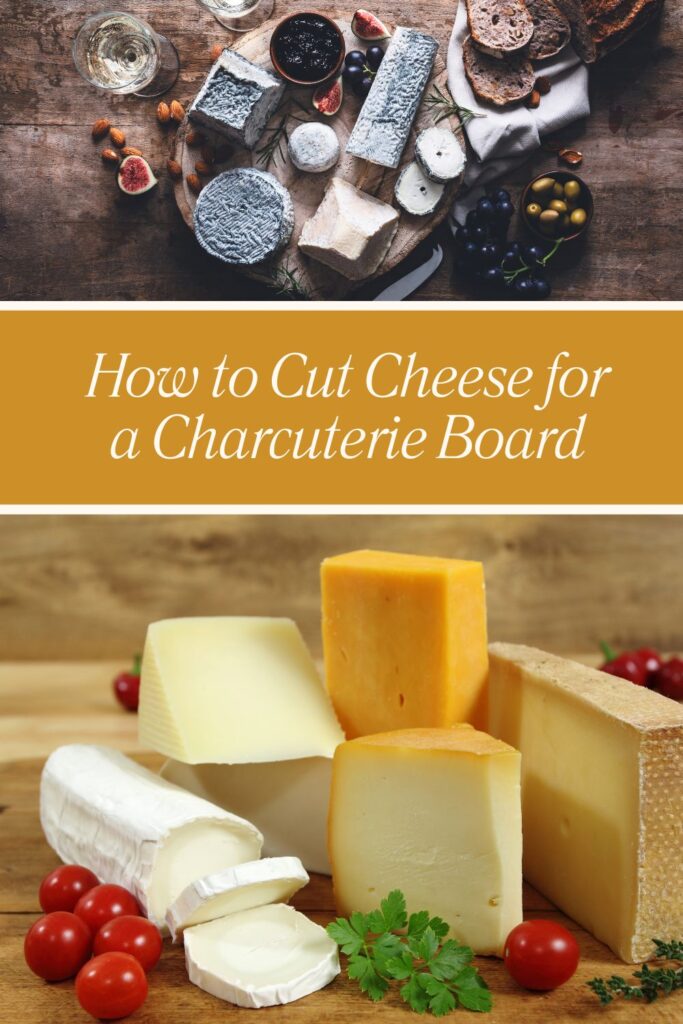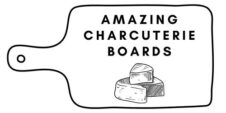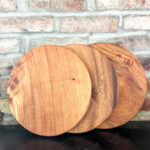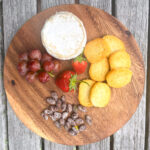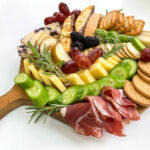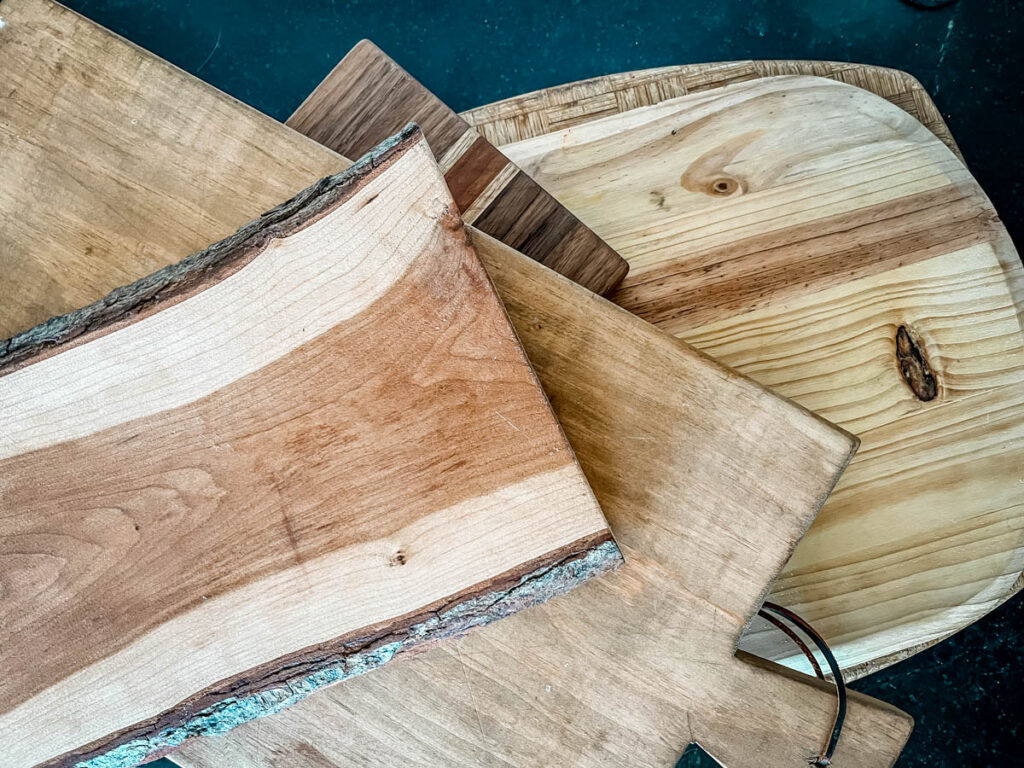Learning to cut cheese not only improves the overall appearance of your charcuterie board, but it can also directly impact the texture and taste of the cheese itself. Different types of cheese benefit from different cutting methods, and the key is to balance cutting the cheese for appearance and flavor. In this article, we’ll explore the top tips for cutting cheese for your charcuterie board including different cutting techniques, ideas for presentation and more.
Cheese is one of the most important ingredients on a charcuterie board – read more about the Best Cheese for Charcuterie Boards to see our favorite types of cheese.
Please note that some of these links may be affiliate links – I will earn a small commission when you make a purchase through one of these links.

Contents
Overview of Cutting Cheese for a Charcuterie board
When assembling a charcuterie board, deciding whether to cut your cheese or leave it intact is an important decision. Cut cheese is often better for presentation as you can lay it out in rounds, rows, layers, and other designs. On the other hand, in terms of flavor, it is often better to cut a few slices of cheese and leave the rest in a block with a knife for guests to cut their own cheese. I’ve found that if you simply put cheese in a block on a board without cutting it, people simply don’t know how to start.
How you decide to cut cheese will depend on a few factors including the overall shape and size of the cheese as well as the texture of cheese. For example, goat cheese is generally crumbly and won’t do well cut into narrow pieces while cheddar cheese is perfect for making slices. Below we’ve chose to describe cutting cheese based on the general shape of the cheese.
How to Cut Cheese for Charcuterie Boards Based on It’s Shape

Round
For round cheeses, achieving the perfect rind-to-paste ratio is key. Cut it into wedges akin to slicing a pie or cake. Begin by halving the wheel, then quartering it. Proceed to bisect each quarter depending on the wheel’s size, aiming for half-ounce portions. Here is an overview of cutting round cheese
- Ensure cheese is at the right temperature and use a suitable knife.
- Place cheese on a stable cutting board and score tough rind if needed.
- Halve the cheese wheel, then quarter it.
- Cut each quarter into smaller wedges for half-ounce portions.
- Adjust cuts for size: more for large wheels, fewer for small ones.
- Arrange wedges on the board with rind outwards and provide utensils for serving.
Examples: Brie, Camembert, Gouda

Square
Similar to round wheels, square cheeses benefit from a balanced rind-to-paste ratio. There are several different shapes you can cut your square cheese into triangles, squares or rectangles. For triangles, begin by halving the cheese diagonally from corner to corner, then quarter it by halving from the opposite corners. Proceed to bisect perpendicularly, from top to bottom and side to side. For square or rectangular slices, cut slices from one end and adjust size to your preference.
- Preparation: Ensure the cheese is at the right temperature for cutting. Soft cheeses should be slightly chilled, while hard cheeses should be at room temperature.
- Use a Suitable Knife: Select a clean, sharp knife appropriate for the cheese type. For harder cheeses, a sturdy knife works well, while for softer cheeses, use a cheese wire or slicer for cleaner cuts.
- Positioning the Cheese: Place the cheese block on a stable cutting board.
- Initial Slicing: Start by cutting the cheese block into slices, either horizontally or vertically, depending on the desired thickness.
- Cut into Portions: Once sliced, cut each piece into smaller portions. For square cheeses, aim for uniform square or rectangular pieces.
- Presentation: Arrange the cut cheese pieces on a serving platter or charcuterie board, ensuring an attractive display. You can also cut just a few slices and leave the block for each person to cut more.
Examples: Cheddar, Edam, Monterey Jack

Logs
Soft goat cheeses and mozzarella typically come in log shapes. The easiest way to cut these is simply Slice them into coins about 1/4 inch thick. For larger diameters like bucheron, cut them in a pie-like fashion after slicing into coins to make rounded triangles.
- Preparation: Ensure the cheese is at the right temperature for cutting. Soft log cheeses should be slightly chilled, while harder varieties can be at room temperature.
- Use a Sharp Knife: Use a clean, sharp knife to cut the log cheese. For softer cheeses, a sharp chef’s knife works well, while for harder cheeses, a sturdy knife or cheese wire is recommended.
- Cutting Technique: Position the log cheese on a stable cutting board. Slice the log cheese crosswise into rounds for individual servings. For softer log cheeses, a gentle sawing motion may be required to prevent squishing. Adjust the thickness of the slices based on preference and the number of servings needed.
Examples: Mozzarella, fresh chévre
Pyramid
For bloomy-rinded cheeses such as pyramids, employ a square-cutting method. Keep the bottom flat, then slice it in half from corner to corner. Proceed to halve it perpendicularly on both sides.
Examples: Bûchette and Valençay
Triangular Wedge
Maximize surface area with thin slices for triangular wedges. Remove top and bottom rinds, then slice lengthwise into thin triangles, leaving the back rind intact as a handle.
Examples: Most cheese that comes as a round is often found as a triangular wedge
Crumbly Cheeses
When serving crumbled cheese on a charcuterie board, aim for a visually appealing presentation that complements the other components. Scatter the crumbles strategically to add texture and depth to the board’s layout. Ensure easy access for guests by placing them alongside complementary items. Label the cheese varieties to guide tasting and appreciation.
- Scatter crumbled cheese evenly across the board.
- Pair with fruits, nuts, or bread to balance flavors and textures.
- Provide small serving utensils for easy portioning.
- Label each cheese variety for clarity and guidance.
Examples: Blue, Parmigiano, Aged Gouda

Tools for Cutting Cheese
Most cheese can be cut simply with a share kitchen knife, but if you will be cutting cheese often or want to step up your designs, the best place to start is with some simple tools for cutting cheese. Below are some of my favorite tools for cutting cheese (click on each to find an example of the exact tools I use in my kitchen):
- Soft cheese knife: features holes to prevent sticking.
- Hard cheese knife: has a sharp edge for clean cuts.
- Cheese spreader knife: ideal for creamy cheeses.
- Used for cutting precise slices of soft and semi-soft cheeses.
- For creating thin slices of semi-hard and hard cheeses.
- Especially useful for cutting large, hard cheeses into manageable pieces.
- For grating hard cheeses like Parmesan.
Top Tips for Serving Cut Cheese
- Temperature Matters: Serve cheese at the appropriate temperature; soft cheeses are best slightly chilled, while hard cheeses are ideal at room temperature.
- Variety is Key: Offer a variety of cheeses with different textures, flavors, and strengths to cater to diverse tastes.
- Labeling: Label each cheese to inform guests about its type, origin, and flavor profile.
- Pairing: Pair cheese with complementary accompaniments such as fruits, nuts, honey, and crackers to enhance flavors and textures.
- Proper Cutting: Use appropriate tools and techniques for cutting each type of cheese to maintain its integrity and flavor.
- Presentation: Arrange cut cheese on a clean, attractive serving platter or charcuterie board, ensuring a visually appealing layout.
- Accessibility: Provide utensils for cutting and serving cheese, ensuring guests can easily portion and enjoy.
- Freshness: Serve freshly cut cheese to preserve its flavor and texture; avoid pre-cutting large quantities to prevent drying out.
- Balance: Aim for a balanced selection of cheeses, considering factors like milk type (cow, goat, sheep), texture (soft, semi-soft, hard), and flavor intensity.
- Enjoyment: Encourage guests to savor and appreciate the cheese by providing guidance on tasting, pairing, and enjoying each variety.
